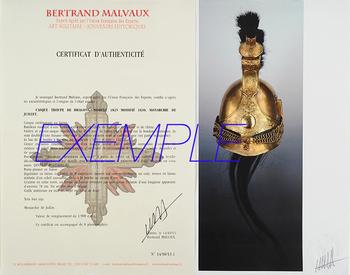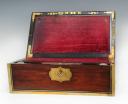
MARINE'S WRITING BOX WITH PATENTED LOCK TOMPSON, United Kingdom, circa 1808. 26712
Sold out
MARINE'S WRITING BOX WITH PATENTED LOCK TOMPSON, United Kingdom, circa 1808. 26712
In mahogany with ebony fillets and brass sticks. Brass side handles, plate on the brass lid engraved with a skull on two crossed thibias evoking the emblem of the pirates (Jolly Roger). Interior lined with burgundy velvet. Interior of the hinged lid, as well as the complete writing case with its pen holder, inkwell and hourglass in crystal and silver-plated metal. Side drawer locks from the inside. Brass lock signed "TOMPSON BIR Mr GR PATENT".
W 45.5cm, H 17cm, D 26.5cm.
United Kingdom.
Reign of George III.
Very good state.
NOTE :
Thompson patented lock
William Tompson's lock design was first patented on December 29, 1808. Its double-action movement is very similar to the earlier patented Turner lock, in which the bolt links and central movable pin initially rise beyond the surface of the lock plate, then only the links. sliding to the left and into the locked position.
Tompson Patent locks are more commonly found in mailboxes; their design allows the surface of the lock plate to be flat and unhindered when in the unlocked position. This differs from Bramah's write box locks whose links and locating pins protrude from the surface of the lock plate whether in the locked or unlocked position.
The surfaces of the lock plates bear the name 'Tompson', usually accompanied by 'Bir.M' (short for Birmingham – the location of its manufacture) and 'GR [George Rex] Patent' below the monarch's crown. These texts are arranged in a curved format, once again reminiscent of the Turner Patent lock.
Some Tompson Patent locks are fitted with a decorative cast brass escutcheon on the front; the keyhole of which is set in the design of the Royal Coat of Arms, partially surrounded by 'Tompson Patent' in raised lettering.
In mahogany with ebony fillets and brass sticks. Brass side handles, plate on the brass lid engraved with a skull on two crossed thibias evoking the emblem of the pirates (Jolly Roger). Interior lined with burgundy velvet. Interior of the hinged lid, as well as the complete writing case with its pen holder, inkwell and hourglass in crystal and silver-plated metal. Side drawer locks from the inside. Brass lock signed "TOMPSON BIR Mr GR PATENT".
W 45.5cm, H 17cm, D 26.5cm.
United Kingdom.
Reign of George III.
Very good state.
NOTE :
Thompson patented lock
William Tompson's lock design was first patented on December 29, 1808. Its double-action movement is very similar to the earlier patented Turner lock, in which the bolt links and central movable pin initially rise beyond the surface of the lock plate, then only the links. sliding to the left and into the locked position.
Tompson Patent locks are more commonly found in mailboxes; their design allows the surface of the lock plate to be flat and unhindered when in the unlocked position. This differs from Bramah's write box locks whose links and locating pins protrude from the surface of the lock plate whether in the locked or unlocked position.
The surfaces of the lock plates bear the name 'Tompson', usually accompanied by 'Bir.M' (short for Birmingham – the location of its manufacture) and 'GR [George Rex] Patent' below the monarch's crown. These texts are arranged in a curved format, once again reminiscent of the Turner Patent lock.
Some Tompson Patent locks are fitted with a decorative cast brass escutcheon on the front; the keyhole of which is set in the design of the Royal Coat of Arms, partially surrounded by 'Tompson Patent' in raised lettering.
Reference :
26712

Next update Friday, april 4th at 1:30 PM
FOR ALL PURCHASES, PAYMENT IN MULTIPLE CHECKS POSSIBLE
bertrand.malvaux@wanadoo.fr 06 07 75 74 63
An authenticity certificate of the item including the description published on the site, the period, the sale price, accompanied by one or more color photographs is automatically provided for any item priced over 130 euros. Below this price, each certificate is charged 5 euros.
Only items sold by me are subject to an authenticity certificate, I do not provide any expert reports for items sold by third parties (colleagues or collectors).










